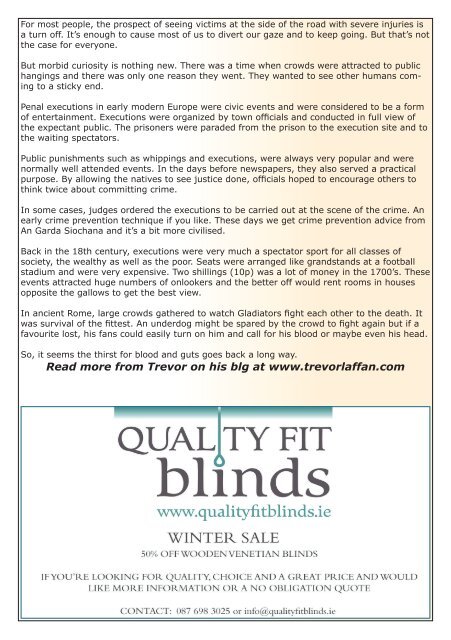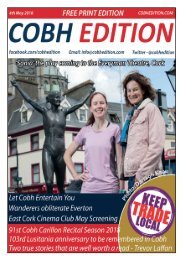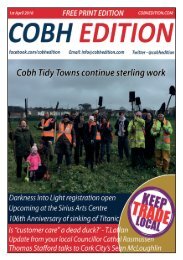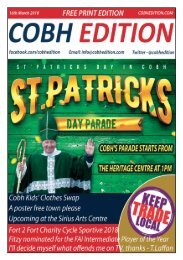COBH EDITION 19TH DECEMBER - DIGITAL VERSION
Cuskinny Christmas Wildlife Walk 2017 Cobh Tidy Towns is delighted to announce that on Wednesday 27th December, wildlife expert Jim Wilson will lead a Free Family Wildlife Walk at the Birdwatch Ireland Cuskinny Marsh Nature Reserve. The meeting point will be the car park at 11 am and no equipment is necessary. This is a wonderful opportunity to learn about the fantastic wildlife living on our doorsteps. Jim is a wildlife writer, international wildlife tour guide, broadcaster, photographer and filmmaker and recently received a lifetime achievement award at the Cork Environmental Forum 2017 Awards.
Cuskinny Christmas Wildlife Walk 2017
Cobh Tidy Towns is delighted to announce that on Wednesday 27th December, wildlife expert Jim Wilson will lead a Free Family Wildlife Walk at the Birdwatch Ireland Cuskinny Marsh Nature Reserve. The meeting point will be the car park at 11 am and no equipment is necessary. This is a wonderful opportunity to learn about the fantastic wildlife living on our doorsteps.
Jim is a wildlife writer, international wildlife tour guide, broadcaster, photographer and filmmaker and recently received a lifetime achievement award at the Cork Environmental Forum 2017 Awards.
You also want an ePaper? Increase the reach of your titles
YUMPU automatically turns print PDFs into web optimized ePapers that Google loves.
For most people, the prospect of seeing victims at the side of the road with severe injuries is<br />
a turn off. It’s enough to cause most of us to divert our gaze and to keep going. But that’s not<br />
the case for everyone.<br />
But morbid curiosity is nothing new. There was a time when crowds were attracted to public<br />
hangings and there was only one reason they went. They wanted to see other humans coming<br />
to a sticky end.<br />
Penal executions in early modern Europe were civic events and were considered to be a form<br />
of entertainment. Executions were organized by town officials and conducted in full view of<br />
the expectant public. The prisoners were paraded from the prison to the execution site and to<br />
the waiting spectators.<br />
Public punishments such as whippings and executions, were always very popular and were<br />
normally well attended events. In the days before newspapers, they also served a practical<br />
purpose. By allowing the natives to see justice done, officials hoped to encourage others to<br />
think twice about committing crime.<br />
In some cases, judges ordered the executions to be carried out at the scene of the crime. An<br />
early crime prevention technique if you like. These days we get crime prevention advice from<br />
An Garda Siochana and it’s a bit more civilised.<br />
Back in the 18th century, executions were very much a spectator sport for all classes of<br />
society, the wealthy as well as the poor. Seats were arranged like grandstands at a football<br />
stadium and were very expensive. Two shillings (10p) was a lot of money in the 1700’s. These<br />
events attracted huge numbers of onlookers and the better off would rent rooms in houses<br />
opposite the gallows to get the best view.<br />
In ancient Rome, large crowds gathered to watch Gladiators fight each other to the death. It<br />
was survival of the fittest. An underdog might be spared by the crowd to fight again but if a<br />
favourite lost, his fans could easily turn on him and call for his blood or maybe even his head.<br />
So, it seems the thirst for blood and guts goes back a long way.<br />
Read more from Trevor on his blg at www.trevorlaffan.com












